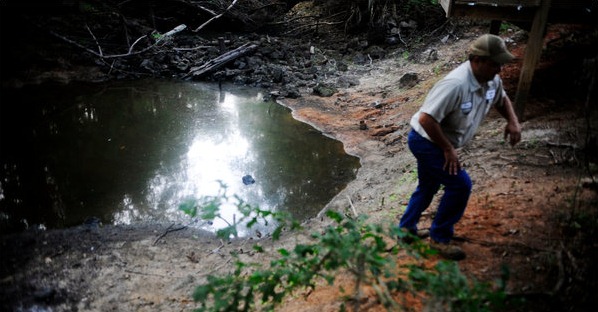Drought spreads its pain across 14 U.S. states – ‘Likely to be a disastrous summer’
By KIM SEVERSON and KIRK JOHNSON
11 July 2011 COLQUITT, Ga. — The heat and the drought are so bad in this southwest corner of Georgia that hogs can barely eat. Corn, a lucrative crop with a notorious thirst, is burning up in fields. Cotton plants are too weak to punch through soil so dry it might as well be pavement. Farmers with the money and equipment to irrigate are running wells dry in the unseasonably early and particularly brutal national drought that some say could rival the Dust Bowl days. “It’s horrible so far,” said Mike Newberry, a Georgia farmer who is trying grow cotton, corn and peanuts on a thousand acres. “There is no description for what we’ve been through since we started planting corn in March.” The pain has spread across 14 states, from Florida, where severe water restrictions are in place, to Arizona, where ranchers could be forced to sell off entire herds of cattle because they simply can’t feed them. In Texas, where the drought is the worst, virtually no part of the state has been untouched. City dwellers and ranchers have been tormented by excessive heat and high winds. As they have been in the southwest, wildfires are chewing through millions of acres. Last month, the United States Department of Agriculture designated all 254 counties in Texas as natural-disaster areas, qualifying them for varying levels of federal relief. More than 30 percent of the state’s wheat fields might be lost, adding pressure to a crop in short supply globally. Even if weather patterns shift and relief-giving rain comes, losses will surely head past $3 billion in that state alone, Texas agricultural officials said. Most troubling is that the drought, which could go down as one of the nation’s worst, has come on extra hot and extra early. It has its roots in 2010 and continued through the winter. The five months from this February to June, for example, were so dry that they shattered a Texas record set in 1917, said Don Conlee, the acting state climatologist. Oklahoma has had only 28 percent of its normal summer rainfall and the heat has blasted past 90 degrees for a month. “We’ve had a two- or three-week start on what is likely to be a disastrous summer,” said Kevin Kloesel, director of the Oklahoma Climatological Survey. […]
Drought Spreads Its Pain Across 14 States
